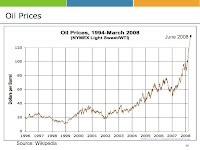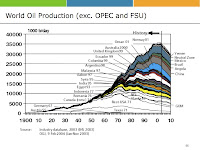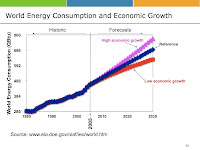 I’m offering one explanation for the recent variation in oil prices and the current economic collapse. It is certainly not the only theory. As for oil prices, it has been suggested that speculators drove up oil prices and then couldn’t maintain the momentum. Sub-prime mortgages and their impact on the banking and financial sectors are most often blamed for the economic melt-down. Perhaps there is no way to absolutely determine the underlying causes for these events.
I’m offering one explanation for the recent variation in oil prices and the current economic collapse. It is certainly not the only theory. As for oil prices, it has been suggested that speculators drove up oil prices and then couldn’t maintain the momentum. Sub-prime mortgages and their impact on the banking and financial sectors are most often blamed for the economic melt-down. Perhaps there is no way to absolutely determine the underlying causes for these events.Nevertheless, the Energy Information Administration of the US Department of Energy has compiled some very intriguing data. The attached chart shows world-wide consumption and production of oil over the period from 2003 to 2010. The data was derived from the EIA World Oil Balance spreadsheet found here:
http://www.eia.doe.gov/oil_gas/petroleum/info_glance/petroleum.html
The chart clearly shows that oil production exceeded consumption for 2004 and 2005. During this period, oil prices ranged from $30 to $60 per barrel. In 2006 demand continued to increase but production could not keep pace. Demand continued to exceed supply for all of 2007 and most of 2008. During this time the strategic reserves were depleted, and just like all good economists would predict, the price of oil skyrocketed from about $50/bbl in Sept. 2006 to almost $150/bbl in July 2008.
We might make a few more observations from this chart. First, in spite of record oil prices over a 3 year period, world-wide production rates never exceeded 86 million barrels per day while consumption reached nearly 87 million. Second, the major collapse in oil price occurred when demand plunged from about 86.5 million barrels/day in Q1 2008 to less than 85 million barrels/day in Q3. Most of this drastic decline occurred in the US. (It is interesting to note that China’s consumption actually increased in the same period!)
Once supply (production) exceeded demand (consumption) the price plummeted.
And we all know how this collapse in consumption has been reflected in the stock market.
One last observation can be made - and it is probably the most important. The EIA forecasts indicate that demand for oil will increase steadily from Q2 2008 until 2010. This prediction is based on an assumption that the recession will end and the economy will begin to grow. Oil production is expected to drop in 2009, and this should stabilize oil prices in the near term. However, the most interesting part is that oil production is somehow expected to reach almost 87 million barrels/day to accommodate the anticipated growth in consumption that comes with the end of the recession.
Where will this additional production come from?
Most of the remaining reserves are from ultra deep water fields, remote areas, or from non-conventional sources (like the tar sands). These projects are being shelved in the current price environment.
If the economy continues to grow, along with it’s associated increase in oil consumption, what will prevent another spike in the price of oil when this expected production increase doesn’t occur?






